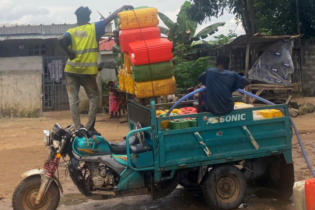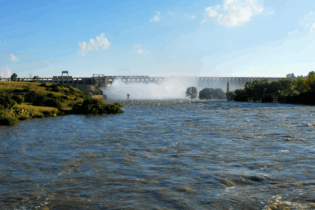Constructed as part of the larger Roodeplaat Bulk Water Supply Project, the Roodeplaat Water Treatment Works is now one of the most advanced water treatment facilities in terms of process configuration in South Africa, Bigen Africa project manager, Ian Pollard, tells Chantelle van Schalkwyk.
This can be attributed to the fact that the City of Tshwane deciding to implement the advanced processes of ozonation and granular activated carbon (GAC) filtration processes proactively, in anticipation of expected future deterioration in raw water quality. “The use of ozone in municipal water treatment is certainly not a new process, but it is not deemed conventional in South Africa. The Roodeplaat plant is currently one of the most advanced plants in terms of process configuration in the country and probably in Africa,” explains Pollard. The 60 Mℓ/d Roodeplaat Water Treatment Works (WTW)was commissioned in 2005 as part of the larger Roodeplaat Bulk Water Supply Project to augment water supply to the rapidly expanding northern areas of the City of Tshwane from feasible local sources in lieu of extending its existing supply scheme from Rand Water (and thus effectively from Lesotho Highlands schemes). The Roodeplaat Dam, situated approximately 20 km north-east of the Pretoria CBD was identified as a feasible local source and a licence to abstract raw water from this dam was issued by the (then) Department of Water Affairs and Forestry (DWAF) to City of Tshwane thereby approving the implementation of phase one of a 60 Mℓ/d bulk water supply scheme. The Roodeplaat Dam is currently classified as highly eutrophied as a result of the influx of treated effluent from two large wastewater treatment facilities situated in the dam’s catchment also owned and operated by the City of Tshwane. Apart from excessive algal growth, which is a direct consequence of eutrophication and relatively easy to remove via flotation for instance, removal of associated algal toxins, complex dissolved manganese and iron, organic constituents responsible for taste and odour-causing compounds and chlorine-resistant pathogens are more difficult and require a series of treatment steps, many of which are viewed as advanced processes. “Although all the treatment processes were included during initial planning of the treatment facility necessary to treat the Roodeplaat water to acceptable potable standards, the City of Tshwane decided to implement the envisaged future advanced processes (in the form of ozonation and GAC) pro-actively in anticipation of expected further deterioration in raw water quality,” says Pollard. He adds that the Temba Roodeplaat Consulting Consortium, of which Bigen Africa is the lead consultant, was subsequently appointed to design the new processes, and a pilot plant was installed at the Roodeplaat WTW and operated for approximately three months to determine various site-specific design parameters, which was, according to Pollard, ultimately used for the detail design and specification of the new processes. Ozone in focus Ozone is a strong oxidant and disinfectant with a variety of applications in water treatment. Unfortunately, ozone as a highly reactive gas cannot be stored in containers and thus needs to be generated at the point of use by passing high voltage electrical current through an oxygen-rich environment. The electrical current splits the oxygen (O2) molecule into two O-atoms and a small portion (e.g. 6 to 12% by weight) of the O-atoms combine with O2 molecules to form O3 i.e. ozone. The amount of ozone generated is dependent on various factors, one of which being the concentration of oxygen in the feed gas to the generator. Three types of feed gases are normally used for large-scale generation of ozone, namely pure oxygen from commercially-supplied liquid oxygen (LOX), pure oxygen produced on-site from air through a process called pressure swing absorption (PSA) or normal air, which is approximately 22% oxygen. For the system installed at Roodeplaat, ozone will be generated from LOX. According to Pollard, the use of ozone in conjunction with GAC filtration offers a number of benefits. Apart from its strong disinfection power, ozone has the ability to alter the molecular structure of complex organic compounds making these more amicable to biological degradation and removal. In addition to its adsorbent properties, GAC is also an excellent medium for the development and proliferation of bacteria that remove organic compounds, many of which are responsible for potentially unacceptable tastes and odours in the final water. At Roodeplaat, ozone will mainly be used for the oxidation of dissolved organic constituents, improved GAC adsorption of organic compounds, disinfection of chlorine resistant pathogens and, to a lesser extent, the removal of complex iron and manganese. The project was implemented through two contracts, one for the civil works and another for the supply and installation of mechanical and electrical equipment. The ozone generation equipment was the single-most expensive component of the mechanical works and was imported from Switzerland. The civil works was completed in December 2011, while the commissioning of the mechanical and electrical works were completed in December 2012. Project breakdown The scope of works basically entailed the construction of two new unit treatment processes, the first being an on-site ozone generation and dosing plant, explains Pollard.“The main components of the plant is an LOX storage facility, a state–of-the-art 37 kg/h ozone generation system comprising three ozone generators from Ozonia in Switzerland, a reinforced concrete main ozone dosing chamber and two intermediary dosing stations at the head of the works and upstream of the sand filters.”The second unit process was the GAC filter gallery comprising 20 filter bays filled with GAC media to provide approximately 12 minutes retention time at maximum hydraulic loading. “Two different types of GAC were installed to compare the full-scale performance and longevity of re-agglomerated GAC versus direct activated carbon,” says Pollard.
He adds that the project has to date been completed – the GAC filters have been fully operational since July 2012 while the ozone generation system was commissioned between September and December 2012. Challenges on-site Planning and integration between the civil and mechanical contractors and works proved especially challenging according to Pollard, as these components were handled under separate contracts. This was also exacerbated by having to undertake construction of the new processes, with the plant remaining fully operational except for a couple of planned short shutdowns for critical tie-ins. However, these challenges were not insurmountable and, as Pollard notes, were overcome through various combined integration and scheduling meetings. “Proper scheduling of works during shutdowns to ensure that maximum amount of work could be executed during each of the shutdown periods was also utilised,” continues Pollard. From green to blue “Although the plant has consistently produced SANS 241 compliant water, there have been reports of water quality problems in the supply region of the plant in the past and hopefully the inclusion of the new processes will go a long way to further enhance the quality of water distributed to the consumer and build trust in the local municipality as the water services provider for the region,” says Pollard. As such, one of the highlights for him was the colour of the water that turned from having a slight greenish tint (still within SANS 241 limits) to that having a deep blue colour after passing through the GAC filters. This is further enhanced by the fact that the client also reported full compliance in terms of the targeted water quality during the last couple of months, he adds. The parameters are now consistently on the low end of the scale rather than just below the upper limits. For him, the project has been unique – and special – for a number of reasons, not least of which are working with advanced processes that are not common, and overcoming the technical challenges in determining the optimum solution. “In this instance, we did a pilot study where we ran a small ozone and GAC pilot plant to test the response of the water prior to finalising the designs. This added almost six months to the design period, but proved worthwhile as various site-specific parameters were determined and used to optimise the design,” says Pollard. “The workmanship on the ozone generators is also really a highlight – it is extremely good,” concludes Pollard.







